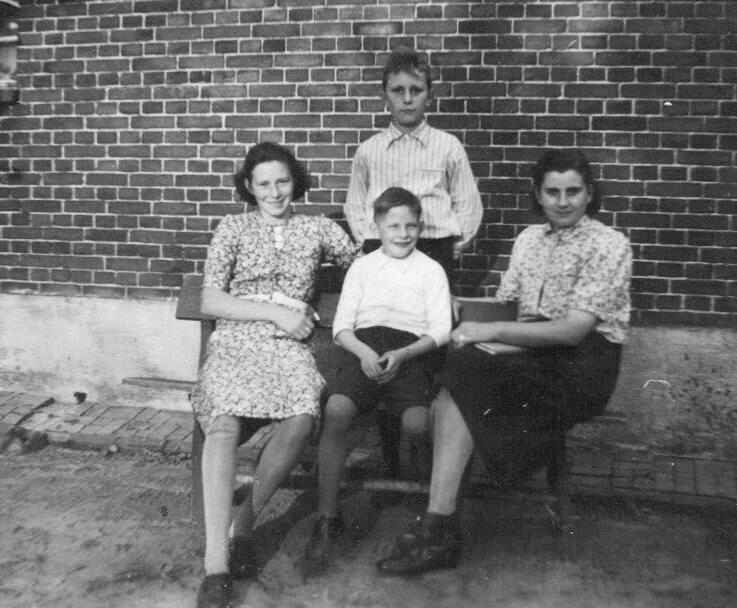
Dutch Village: Zijtaart--Children's Clothing

Figure 1.-- Notice this photo of the Vervoort family , taken in warm weather during 1943. We see two of the Vervoort children children) with a friend, Bert Kanters and an older married lady. Standing in back is Harrie Vervoort (probably about 11 or 12). Sitting in front (from left to right) is Betje Vervoort, Harrie's older sister (about 17 or 18); Bert Kanters (about 10 years old); and Miet de Valk, who was married to Willem van
Asseldonk (not shown). The children all seem to be wearing long stockings even with summer clothes.
|
|
Virtually all the boys in Zijtaart wear short pants for both school and play. Short pants in the voillage school were nearly universal. The shorts seem cut unusually long for the 1940s. We note boys wearing suit jackets and sweaters. There were several different types of suits. Some boys for chores around the house seem to have worn long trousers. The rural location and Catholic orientation may explain why so many children in the village wore long stockings. During the summer we see the children wearing knee socks, but on cools the children seem to have mostly worn lon stockings. A reader writes, "I agree that these considerations are important. I think Catholic and rural families in the Netherlands insisted on long stockings for their children more often rgan Protestant and urban families. The situation here may have been similar to Quebec, where long stockings were much more common than in Western Canada. In Germany class seems also to have been a factor, but not the only one. The van der Vens, for instance, seem to have been fairly upper class (but also rural and farming families)." We also note many boys wearing wooden shoes. This was much more common in rural areas than in the cities. Wooden shoes were practical for farm work. Wooden shoes were particuilsrly common for children during the War when leather shoes were rationed and even then difficult to obtain.
Headwear
We do not see the boys wearing headwear.
Shirts
We boys wear a variety of mostly lonf-sleeved collared shirts. Note that the boys button their collars even when not wearing ties.
Suits
Sweaters
Pants
Virtually all the boys in Zijtaart wear short pants for both school and play. Short pants in the voillage school were nearly universal. The shorts seem cut unusually long for the 1940s. We note boys wearing suit jackets and sweaters. There were several different types of suits. Some boys for chores around the house seem to have worn long trousers.
Hosiery
The rural location and Catholic orientation may explain why so many children in the village wore long stockings. During the summer we see the children wearing knee socks, but on cools the children seem to have mostly worn lon stockings. A reader writes, "I agree that these considerations are important. I think Catholic and rural families in the Netherlands insisted on long stockings for their children more often rgan Protestant and urban families. The situation here may have been similar to Quebec, where long stockings were much more common than in Western Canada. In Germany class seems also to have been a factor, but not the only one. The van der Vens, for instance, seem to have been fairly upper class (but also rural and farming families)." Another reader writes, "I believe you are correct about long stockings in Zijtaart being common, not just in formal portraits, but for everyday wear. Notice this photo of the Vervoort family , taken in warm weather during 1943. We see two of the Vervoort children children) with a friend, Bert Kanters and an older married lady. Standing in back is Harrie Vervoort (probably about 11 or 12). Sitting in front (from left to right) is Betje Vervoort, Harrie's older sister (about 17 or 18); Bert Kanters (about 10 years old); and Miet de Valk, who was married to Willem van
Asseldonk (not shown). The children all seem to be wearing long stockings even with summer clothes. Certainly this is true of Bertje and Bert, who wear tan and brown long stockings. We can't see Harrie's legs but he is probably wearing long stockings like his younger friend, Bert. All of these people seem to be dressed for warm weather with only shirt sleeves, summer dresses, etc. Notice that the older lady wears only ankle socks. Long stockings for boys seem to have quite
normal, even for informal occasions like the present one, although some of the photos of boys in Zijtaart show them wearing knee socks in summer.
Footwear
We also note many boys wearing wooden shoes. This was much more common in rural areas than in the cities. Wooden shoes were practical for farm work. Wooden shoes were particuilsrly common for children during the War when leather shoes were rationed and even then difficult to obtain. Notice that none of the boys wear sandals.
HBC

Navigate the Boys' Historical Clothing Web Site:
[Return to the Main Zijtaart page]
[Return to the Dutch regional pages]
[Introduction]
[Activities]
[Biographies]
[Chronology]
[Clothing styles]
[Countries]
[Bibliographies]
[Contributions]
[FAQs]
[Dutch glossary]
[Images]
[Links]
[Registration]
[Boys' Clothing Home]
Navigate the Boys' Historical Clothing Dutch pages:
[Maiken Island]
[Dutch boys bangs]
[Dutch choirs]
[Dutch school uniform]
[Dutch catalogs]
[Dutch fashion magazines]
[Dutch post cards]
[Dutch royals]
[Dutch youth groups]
Navigate the Boys' Historical Clothing national pages:
[Return to the Main Dutch page]
[Return to the Main countries page]
[Australia]
[Belgium]
[England]
[France]
[Germany]
[Ireland]
[Italy]
[Japan]
[Korea]
[Mexico]
[Scotland]
[United States]
Created: 4:02 AM 11/28/2008
Last updated: 4:03 AM 11/28/2008



